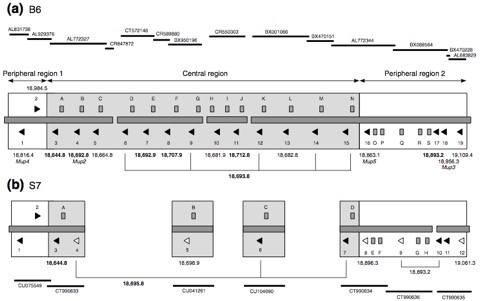First paper on a systematic analysis of MUP expression

Mudge JM, Armstrong SD, McLaren K, Beynon RJ, Hurst JL, Nicholson C, Robertson DH, Wilming LG, Harrow JL. (2008) Dynamic instability of the major urinary protein gene family revealed by genomic and phenotypic comparisons between C57 and 129 strain mice. [PUBMED][PDF]
BACKGROUND: The major urinary proteins (MUPs) of Mus musculus domesticus are deposited in urine in large quantities, where they bind and release pheromones and also provide an individual 'recognition signal' via their phenotypic polymorphism. Whilst important information about MUP functionality has been gained in recent years, the gene cluster is poorly studied in terms of structure, genic polymorphism and evolution.
RESULTS: We combine targeted sequencing, manual genome annotation and phylogenetic analysis to compare the Mup clusters of C57BL/6J and 129 strains of mice. We describe organizational heterogeneity within both clusters: a central array of cassettes containing Mup genes highly similar at the protein level, flanked by regions containing Mup genes displaying significantly elevated divergence. Observed genomic rearrangements in all regions have likely been mediated by endogenous retroviral elements. Mup loci with coding sequences that differ between the strains are identified--including a gene/pseudogene pair--suggesting that these inbred lineages exhibit variation that exists in wild populations. We have characterized the distinct MUP profiles in the urine of both strains by mass spectrometry. The total MUP phenotype data is reconciled with our genomic sequence data, matching all proteins identified in urine to annotated genes.
CONCLUSION: Our observations indicate that the MUP phenotypic polymorphism observed in wild populations results from a combination of Mup gene turnover coupled with currently unidentified mechanisms regulating gene expression patterns. We propose that the structural heterogeneity described within the cluster reflects functional divergence within the Mup gene family.